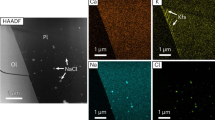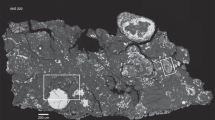Abstract
The surface mineralogy of dwarf planet Ceres appears to be dominated by products of rock–fluid interactions, such as phyllosilicates—some of which are NH4-bearing—and carbonates1,2,3. Elemental concentrations derived from the inferred mineral mixing fractions, however, do not match measurements of H, C, K and Fe on Ceres4. A complicating factor in assessing Ceres’s unique surface composition is the secular accretion of asteroids typical of chondritic compositions. Here we show that Ceres’s mineral and elemental data can be explained by the presence of carbonaceous chondritic-like materials (~50–60 vol%), possibly due to infalling asteroids, admixed with aqueously altered endogenic materials that contain higher-than-chondritic concentrations of carbon. We find that Ceres’s surface may contain up to 20 wt% of carbon, which is more than five times higher than in carbonaceous chondrites. The coexistence of phyllosilicates, magnetite, carbonates and a high carbon content implies rock–water alteration played an important role in promoting widespread carbon chemistry. These findings unveil pathways for the synthesis of organic matter, with implications for their transport across the Solar System.
This is a preview of subscription content, access via your institution
Access options
Access Nature and 54 other Nature Portfolio journals
Get Nature+, our best-value online-access subscription
$29.99 / 30 days
cancel any time
Subscribe to this journal
Receive 12 digital issues and online access to articles
$119.00 per year
only $9.92 per issue
Buy this article
- Purchase on Springer Link
- Instant access to full article PDF
Prices may be subject to local taxes which are calculated during checkout



Similar content being viewed by others
Data availability
The data that support the plots within this paper and other findings of this study are available from the corresponding author upon reasonable request.
References
De Sanctis, M. C. et al. Ammoniated phyllosilicates with a likely outer Solar System origin on (1) Ceres. Nature 528, 241–244 (2015).
Ammannito, E. et al. Distribution of phyllosilicates on the surface of Ceres. Science 353, aaf4279 (2016).
Carrozzo, F. G. et al. Nature, formation, and distribution of carbonates on Ceres. Sci. Adv. 4, e1701645 (2018).
Prettyman, T. H. et al. Extensive water ice within Ceres’ aqueously altered regolith: evidence from nuclear spectroscopy. Science 355, 55–59 (2017).
Fu, R. R. et al. The interior structure of Ceres as revealed by surface topography. Earth. Planet. Sci. Lett. 476, 153–164 (2017).
Marchi, S. et al. The missing large impact craters on Ceres. Nat. Commun. 7, 12257 (2016).
Castillo-Rogez, J. C. & McCord, T. B. Ceres’ evolution and present state constrained by shape data. Icarus 205, 443–459 (2010).
Bowling, T. et al. Post-impact thermal structure and cooling timescales of occator crater on asteroid 1 Ceres. Icarus https://doi.org/10.1016/j.icarus.2018.08.028 (2018).
Daly, R. T. & Schultz, P. H. Predictions for impactor contamination on Ceres based on hypervelocity impact experiments. Geophys. Res. Lett. 42, 7890–7898 (2015).
DeMeo, F. E. & Carry, B. Solar System evolution from compositional mapping of the asteroid belt. Nature 505, 629–634 (2014).
McKinnon, W. B. Where did Ceres accrete? In Proc. Conf. Asteroids, Comets, Meteors 2012 abstr. 6475 (LPI, 2012). http://www.lpi.usra.edu/meetings/acm2012/pdf/6475.pdf
Kretke, K. A., Bottke, W. F., Levison, H. F. & Kring, D. A. Mixing of the asteroid belt due to the formation of the giant planets. In Proc. Conf. Accretion: Building New Worlds 2017 LPI contribution no. 2043, abstr. 2027 (LPI, 2017).
De Sanctis, M. C. et al. Bright carbonate deposits as evidence of aqueous alteration on (1) Ceres. Nature 536, 54–57 (2016).
De Sanctis, M. C. et al. Localized aliphatic organic material on the surface of Ceres. Science 355, 719–722 (2017).
Raponi, A. et al. Mineralogical mapping of Coniraya quadrangle of the dwarf planet Ceres. Icarus https://doi.org/10.1016/j.icarus.2017.10.023 (2017).
Raponi, A. et al. Mineralogy of Occator crater on Ceres and insight into its evolution from the properties of carbonates, phyllosilicates, and chlorides. Icarus https://doi.org/10.1016/j.icarus.2018.02.001 (2018).
Kurokawa, H. et al. A Bayesian approach to deriving Ceres surface composition from Dawn VIR data: initial quantification of bright spot and typical dark material phases with this method. In 49th Lunar Planetary Sci. Conf. 2018 LPI contribution no. 2083, abstr. 1908 (LPI, 2018).
Howard, K. T., Alexander, C. M. O.’D., Schrader, D. L. & Dyl, K. A. Classification of hydrous meteorites (CR, CM and C2 ungrouped) by phyllosilicate fraction: PSD-XRD modal mineralogy and planetesimal environments. Geochim. Cosmochim. Acta 149, 206–222 (2015).
King, A. J., Schofield, P. F., Howard, K. T. & Russell, S. S. Modal mineralogy of CI and CI-like chondrites by X-ray diffraction. Geochim. Cosmochim. Acta 165, 148–160 (2015).
Castillo-Rogez, J. et al. Insights into Ceres’s evolution from surface composition. Meteorit. Planet. Sci. 53, 1820–1843 (2018).
McSween, H. Y. Jr. et al. Carbonaceous chondrites as analogs for the composition and alteration of Ceres. Meteorit. Planet. Sci. 53, 1793–1804 (2018).
Hendrix, A. R., Vilas, F. & Li, J.-Y. Ceres: sulfur deposits and graphitized carbon. Geophys. Res. Lett. 43, 8920–8927 (2016).
Prettyman T. H. et al. Elemental composition and mineralogy of Vesta and Ceres: distribution and origins of hydrogen-bearing species. Icarus https://doi.org/10.1016/j.icarus.2018.04.032 (2018).
Kaplan, H. H., Milliken, R. E. & Alexander, C. M. O’D. New constraints on the abundance and composition of organic matter on Ceres. Geophys. Res. Lett. 45, 5274–5282 (2018).
De Sanctis, M. C. et al. Characteristics of organic matter on Ceres from VIR/Dawn high spatial resolution spectra. Mon. Not. R. Astron. Soc. 482, 2407–2421 (2019).
Mennella, V., Baratta, G. A., Esposito, A., Ferini, G. & Pendleton, Y. J. The effects of ion irradiation on the evolution of the carrier of the 3.4 micron interstellar absorption band. Astrophys. J. 587, 727–738 (2003).
Godard, M. et al. Ion irradiation of carbonaceous interstellar analogues. Effects of cosmic rays on the 3.4 μm interstellar absorption band. Astron. Astrophys. 529, A146 (2011).
Alexander, C. M. O.’D., Howard, K. T., Bowden, R. & Fogel, M. L. The classification of CM and CR chondrites using bulk H, C and N abundances and isotopic compositions. Geochim. Cosmochim. Acta 123, 244–260 (2013).
Schulte, M. & Shock, E. Coupled organic synthesis and mineral alteration on meteorite parent bodies. Meteorit. Planet. Sci. 39, 1577–1590 (2004).
Vinogradoff, V., Bernard, S., Le Guillou, C. & Remusat, L. Evolution of interstellar organic compounds under asteroidal hydrothermal conditions. Icarus 305, 358–370 (2018).
Lodders, K. & Fegley, B. Jr The Planetary Scientist’s Companion (Oxford Univ. Press, Oxford, 1998).
Britt, D. T. & Consolmagno, G. J. Stony meteorite porosities and densities: a review of the data through 2001. Meteorit. Planet. Sci. 38, 1161–1180 (2003).
O’Brien, D. P. et al. Constraining the cratering chronology of Vesta. Planet. Space. Sci. 103, 131–142 (2014).
Vokrouhlický, D., Bottke, W. F. & Nesvorný, D. Capture of trans-neptunian planetesimals in the main asteroid belt. Astron. J. 152, 39 (2016).
Leinhardt, Z. M. & Stewart, S. T. Collisions between gravity-dominated bodies. I. Outcome regimes and scaling laws. Astrophys. J. 745, 79 (2012).
Marchi, S., Bottke, W. F., Kring, D. A. & Morbidelli, A. The onset of the lunar cataclysm as recorded in its ancient crater populations. Earth. Planet. Sci. Lett. 325, 27–38 (2012).
Day, J. M. D., Walker, R. J., Qin, L. & Rumble, D. III Late accretion as a natural consequence of planetary growth. Nat. Geosci. 5, 614–617 (2012).
Marchi, S. et al. The violent collisional history of asteroid 4 Vesta. Science 336, 690–693 (2012).
Marchi, S. et al. High-velocity collisions from the lunar cataclysm recorded in asteroidal meteorites. Nat. Geosci. 6, 303–307 (2013).
Mandler, B. E. & Elkins-Tanton, L. T. The origin of eucrites, diogenites, and olivine diogenites: magma ocean crystallization and shallow magma chamber processes on Vesta. Meteorit. Planet. Sci. 48, 2333–2349 (2013).
Ermakov, A. I. et al. Constraints on Ceres’ internal structure and evolution from its shape and gravity measured by the dawn spacecraft. J. Geophys. Res. Planets 122, 2267–2293 (2017).
Hapke, B. Theory of Reflectance and Emittance Spectroscopy 2nd edn (Cambridge Univ. Press, Cambridge, 2012).
Ciarniello, M. et al. Spectrophotometric properties of dwarf planet Ceres from the VIR spectrometer on board the Dawn mission. Astron. Astrophys. 598, A130 (2017).
Carli, C., Ciarniello, M., Capaccioni, F., Serventi, G. & Sgavetti, M. Spectral variability of plagioclase-mafic mixtures (2): investigation of the optical constant and retrieved mineral abundance dependence on particle size distribution. Icarus 235, 207–219 (2014).
Davidsson, B. J. R., Gutiérrez, P. J. & Rickman, H. Physical properties of morphological units on Comet 9P/Tempel 1 derived from near-IR Deep Impact spectra. Icarus 201, 335–357 (2009).
Ciarniello, M., Capaccioni, F. & Filacchione, G. A test of Hapke’s model by mean of Monte Carlo ray-tracing. Icarus 237, 293–305 (2014).
Schröder, S. E. et al. Resolved spectrophotometric properties of the Ceres surface from Dawn Framing Camera images. Icarus 288, 201–225 (2017).
Mustard, J. F. & Pieters, C. M. Photometric phase functions of common geologic minerals and applications to quantitative analysis of mineral mixture reflectance spectra. J. Geophys. Res. 94, 13619–13634 (1989).
Prettyman, T. H. et al. Dawn’s gamma ray and neutron detector. Space Sci. Rev. 163, 371–459 (2011).
Alexander, C. M. O.’D. et al. The provenances of asteroids, and their contributions to the volatile inventory of the terrestrial planets. Science 337, 721–723 (2012).
Villarreal, M. N. et al. The dependence of the Cerean exosphere on solar energetic particle events. Astrophys. J. Lett. 838, L8 (2017).
Judge, D. L., McMullin, D. R. & Ogawa, H. S. Absolute solar 30.4 nm flux from sounding rocket observations during the solar cycle 23 minimum. J. Geophys. Res. 104, 28321–28324 (1999).
Mennella, V., Brucato, J., Colangeli, L., Palumbo., P. & Bond, C.-H. Formation in carbon grains by exposure to atomic hydrogen: the evolution of the carrier of the interstellar 3.4 micron band. Astrophys. J. 569, 531–540 (2002).
Takir, D. et al. Nature and degree of aqueous alteration in CM and CI carbonaceous chondrites. Meteorit. Planet. Sci. 48, 1618–1637 (2013).
Zubko, V. G. et al. Optical constants of cosmic carbon analogue grains—I. Simulation of clustering by a modified continuous distribution of ellipsoids. Mon. Not. R. Astron. Soc. 282, 1321–1329 (1996).
Gautier, M., Muller, F., Le Forestier, L., Beny, J. M. & Guegan, R. NH4-smectite: characterization, hydration properties and hydro mechanical behaviour. Appl. Clay Sci. 49, 247–254 (2010).
Roberts W. L., Campbell T. J. & Rapp G. R. Encyclopedia of Minerals (Van Nostrand Reinhold, New York, 1990).
Acknowledgements
This work was supported by the NASA Dawn project. We thank H. Y. McSween, B. L. Ehlmann, M. Villarreal and S. Protopapa for their insightful comments.
Author information
Authors and Affiliations
Contributions
S.M. conceived the work. A.R., M.C.D.S., E.A., M.C., H.K. and E.P. provided spectral models. T.H.P. and N.Y. provided elemental models. All authors contributed to the interpretation of the results and to the writing of the manuscript.
Corresponding author
Ethics declarations
Competing interests
The authors declare no competing interests.
Additional information
Publisher’s note: Springer Nature remains neutral with regard to jurisdictional claims in published maps and institutional affiliations.
Supplementary information
Supplementary Information
Supplementary Tables 1–3, Supplementary Figures 1–3
Rights and permissions
About this article
Cite this article
Marchi, S., Raponi, A., Prettyman, T.H. et al. An aqueously altered carbon-rich Ceres. Nat Astron 3, 140–145 (2019). https://doi.org/10.1038/s41550-018-0656-0
Received:
Accepted:
Published:
Issue Date:
DOI: https://doi.org/10.1038/s41550-018-0656-0
This article is cited by
-
Influence of pH on the Hydrothermal Synthesis of Al-Substituted Smectites (Saponite, Beidellite, and Nontronite)
Clays and Clay Minerals (2023)
-
Geologically rapid aqueous mineral alteration at subfreezing temperatures in icy worlds
Nature Astronomy (2022)
-
Deciphering Redox State for a Metal-Rich World
Space Science Reviews (2022)
-
Determining the Relative Cratering Ages of Regions of Psyche’s Surface
Space Science Reviews (2022)
-
GAUSS - genesis of asteroids and evolution of the solar system
Experimental Astronomy (2021)



